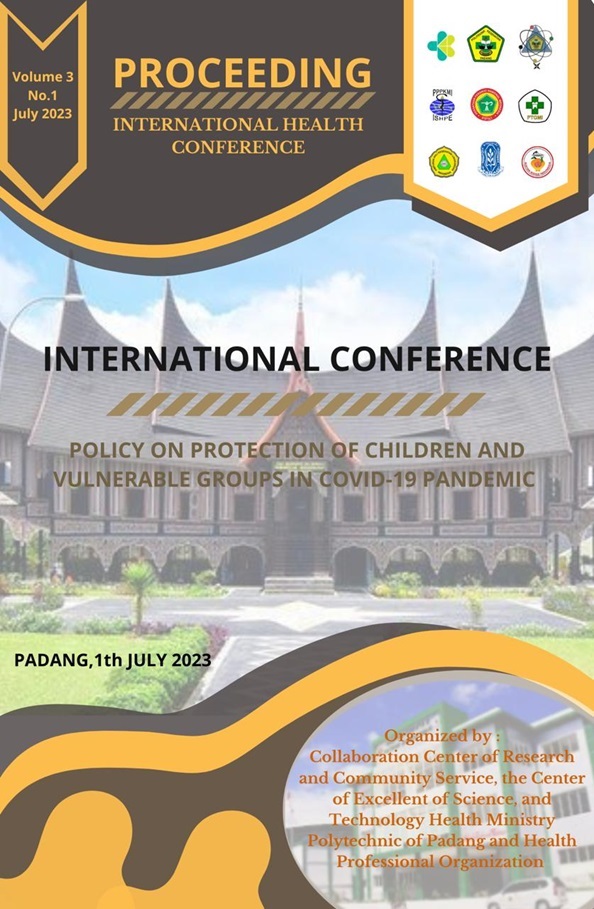Vegetable Cooking Model in the Effort to Increase Vegetable Consumption for School Children in the Work Area of the Kuranji Community Health Center in 2020
Abstract
Basic Health Research data in 2013 showed that the population aged 10 years who consumed less fruit and vegetables in Indonesia was 93.5% and Riskesdas data in 2018 was 95.5%, while West Sumatra in 2013 was 97%, (Depkes.2013). Based on Riskesdas, West Sumatra is still above the Indonesian average. This study aims to determine the effectiveness of the vegetable cooking model in increasing vegetable consumption for school children. The research was conducted in the working area of the Kuranji Community Health Centre. The population in this study were junior high school students in the Korong Gadang village, Kuranji district. Samples were taken purposively as many as 35 people. To find out the amount of consumption of the vegetable model consumed by the child, it was done by weighing using a digital food scale with an accuracy of 0.1 grams and a questionnaire to determine the identity of the sample and the sample's response to the vegetable cooking model. The provision of food is carried out in the time span for interlude, namely at 10.00-11.00 or at 16.00-17.00. Each child is only given one type of cuisine in 1 day. For data collection, it is assisted by graduates of the Department, who previously conducted a perception equation. The data was processed using a computer and analyzed descriptively. Most of the samples stated that the portion of the vegetable dish model given was in the medium category, namely the highest vegetable bakwan as much as 88.6%, skotel vegeta 80%, and others above 50% and most samples liked the vegetable model given, which was the highest in vegetable bakwan (74 ,3%) while the others were above 50% and no sample stated that they did not like the given vegetable model. The number of vegetables contained in the vegetable model available for one serving ranges from 35gr – 50gr. So that by presenting just one type of vegetable model in one day, it can increase vegetable consumption in the sample by around 35gr –50 gr. It is necessary to disseminate information to the community so that the community can produce models of vegetable dishes that are already available and cooperate with the school to provide vegetable cooking models so that they are always available in the school canteen.
Downloads
References
Dapartemen Kesehatan RI. (2013). Riset Kesehatan Dasar. Badan Penelitian dan Pengembangan Kesehatan Kementerian Kesehatan RI.
Dapartemen Kesehatan RI. (2018). Riset Kesehatan Dasar. Badan Penelitian dan
P engembangan Kesehatan Kementerian Kesehatan RI.
Kementrian Kesehatan RI. (2014). Pedoman Gizi Seimbang, Jakarta.
Nakita. (2010). Sehat Dan Bugar Berkat Gizi Seimbang, Jakarta: Kompas Gramedia.
R.M. Sumoprastowo. (2000). Memilih dan menyimpan sayur mayur, buah-buahan, dan bahan makanan, Jakarta: Bumi Aksara.
Ramayulis, R.. (2015). 230 Jus Pengendali Penyakit Plus Kebugaran & Kecantikan ala Rita Ramayulis., Jakarta: Gramedia.
Ruwaidah A. (2007). Penyakit Akibat Lalai Mengkonsumsi Buah Dan Sayur Serta Solusi Penyembuhannya.
Safnizul Gusti. (2004). Gambaran konsumsi sayuran pada penghuni asrama mahasiswa Universitas Indonesia.
Santoso. (2004). Kesehatan Dan Gizi, Jakarta: Rineka Cipta.
Sunita Almatsier. (2004). Prinsip Dasar Ilmu Gizi, Jakarta: PT. Gramedia Pustaka Utama. Titi Sekarindah, H.R. (2008). Terapi Jus Buah dan Sayur., jakarta: Puspa Swara.










